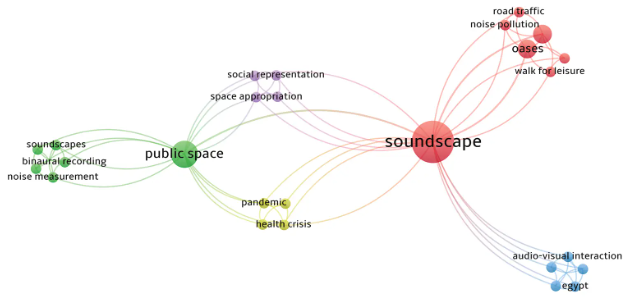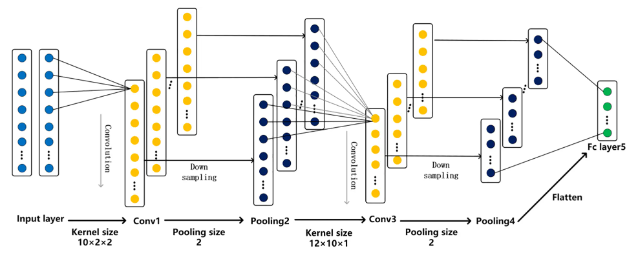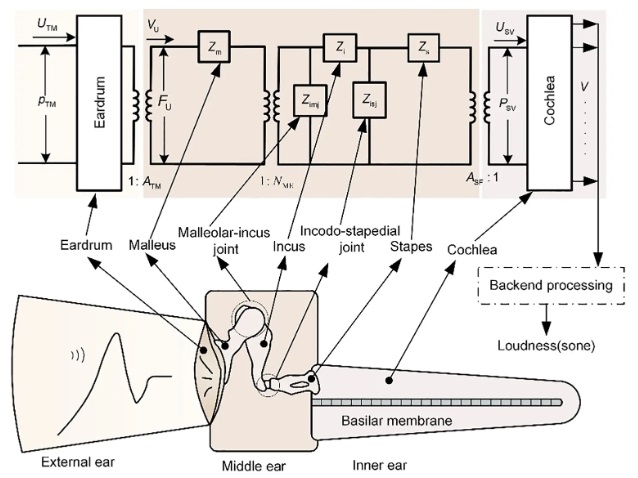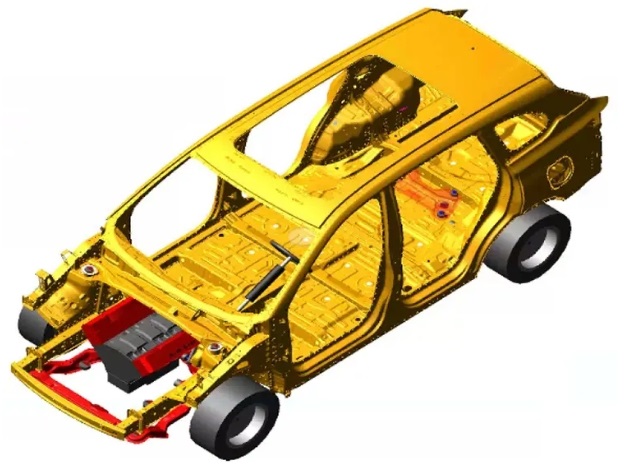A remaining useful life prediction method based on CNN-BiLSTM feature transfer in a high-noise environment
Abstract
Prognosis and health management (PHM) is a comprehensive technique for fault detection, prediction, and health management. However, achieving accurate predictions of remaining useful life (RUL) under complex working conditions such as is still High-Noise Environment a challenge. Therefore, this paper proposes a feature transfer model based on Convolutional Neural Networks (CNN) and Bidirectional Long Short-Term Memory Neural Networks (BiLSTM) to predict RUL. In the feature extraction stage, On the basis of signal decomposition using local mean values,CNN is used to extract the degradation features. Secondly, the health factors are constructed by monotonicity and correlation to filter the features again. Thirdly, it uses BiLSTM to model the time series data in the RUL prediction stage. Then, it introduces the transfer learning algorithm to solve the problem of different data distribution due to the inconsistent working conditions of mechanical equipment data and estimates the confidence interval of the RUL by the Monte Carlo simulation technique. Finally, the effectiveness of our constructed framework via CNN-BiLSTM model on a publicly available degradation simulation dataset of turbine engines.
References
[1]Khan A, Azad MM, Sohail M, et al. A Review of Physics-based Models in Prognostics and Health Management of Laminated Composite Structures. International Journal of Precision Engineering and Manufacturing-Green Technology. 2023; 10(6): 1615-1635. doi: 10.1007/s40684-023-00509-4
[2]Nguyen KTP, Medjaher K, Tran DT. A review of artificial intelligence methods for engineering prognostics and health management with implementation guidelines. Artificial Intelligence Review. 2022; 56(4): 3659-3709. doi: 10.1007/s10462-022-10260-y
[3]Cai B, Fan H, Shao X, et al. Remaining useful life re-prediction methodology based on Wiener process: Subsea Christmas tree system as a case study. Computers & Industrial Engineering. 2021; 151: 106983. doi: 10.1016/j.cie.2020.106983
[4]Ouyang T, Wang C, Xu P, et al. Prognostics and health management of lithium-ion batteries based on modeling techniques and Bayesian approaches: A review. Sustainable Energy Technologies and Assessments. 2023; 55: 102915. doi: 10.1016/j.seta.2022.102915
[5]Deng W, Nguyen KTP, Medjaher K, et al. Physics-informed machine learning in prognostics and health management: State of the art and challenges. Applied Mathematical Modelling. 2023; 124: 325-352. doi: 10.1016/j.apm.2023.07.011
[6]Chen J, Huang R, Chen Z, et al. Transfer learning algorithms for bearing remaining useful life prediction: A comprehensive review from an industrial application perspective. Mechanical Systems and Signal Processing. 2023; 193: 110239. doi: 10.1016/j.ymssp.2023.110239
[7]Li X, Yu D, Søren Byg V, et al. The development of machine learning-based remaining useful life prediction for lithium-ion batteries. Journal of Energy Chemistry. 2023; 82: 103-121. doi: 10.1016/j.jechem.2023.03.026
[8]Gebraeel N, Lei Y, Li N, et al. Prognostics and remaining useful life prediction of machinery: advances, opportunities and challenges. Journal of Dynamics, Monitoring and Diagnostics. 2023; 1-12.
[9]Si X, Li T, Zhang Q, et al. Prognostics for Linear Stochastic Degrading Systems with Survival Measurements. IEEE Transactions on Industrial Electronics. 2020; 67(4): 3202-3215. doi: 10.1109/tie.2019.2908617
[10]Zhang J, Li X, Tian J, et al. An integrated multi-head dual sparse self-attention network for remaining useful life prediction. Reliability Engineering & System Safety. 2023; 233: 109096. doi: 10.1016/j.ress.2023.109096
[11]Wang B, Lei Y, Li N, et al. A Hybrid Prognostics Approach for Estimating Remaining Useful Life of Rolling Element Bearings. IEEE Transactions on Reliability. 2020; 69(1): 401-412. doi: 10.1109/tr.2018.2882682
[12]Li Y, Chen Y, Hu Z, et al. Remaining useful life prediction of aero-engine enabled by fusing knowledge and deep learning models. Reliability Engineering & System Safety. 2023; 229: 108869. doi: 10.1016/j.ress.2022.108869
[13]Dong S, Xiao J, Hu X, et al. Deep transfer learning based on Bi-LSTM and attention for remaining useful life prediction of rolling bearing. Reliability Engineering & System Safety. 2023; 230: 108914. doi: 10.1016/j.ress.2022.108914
[14]Wang Z, Ta Y, Cai W, et al. Research on a remaining useful life prediction method for degradation angle identification two-stage degradation process. Mechanical Systems and Signal Processing. 2023; 184: 109747. doi: 10.1016/j.ymssp.2022.109747
[15]Wei Y, Wu D, Terpenny J. Bearing remaining useful life prediction using self-adaptive graph convolutional networks with self-attention mechanism. Mechanical Systems and Signal Processing. 2023; 188: 110010. doi: 10.1016/j.ymssp.2022.110010
[16]Tian, Zhigang, R. Wong, and R. Safaei. A neural network approach for remaining useful life prediction utilizing both failure and suspension histories. Mechanical Systems & Signal Processing 24.5(2010):1542-1555.
[17]Guo L, Lei Y, Xing S, et al. Deep Convolutional Transfer Learning Network: A New Method for Intelligent Fault Diagnosis of Machines with Unlabeled Data. IEEE Transactions on Industrial Electronics. 2019; 66(9): 7316-7325. doi: 10.1109/tie.2018.2877090
[18]Pei H. Review of Machine Learning Based Remaining Useful Life Prediction Methods for Equipment. Journal of Mechanical Engineering. 2019; 55(8): 1. doi: 10.3901/jme.2019.08.001
[19]Li Z, Wu D, Hu C, et al. An ensemble learning-based prognostic approach with degradation-dependent weights for remaining useful life prediction. Reliability Engineering & System Safety. 2019; 184: 110-122. doi: 10.1016/j.ress.2017.12.016
[20]Xu D, Xiao X, Liu J, et al. Spatio-temporal degradation modeling and remaining useful life prediction under multiple operating conditions based on attention mechanism and deep learning. Reliability Engineering & System Safety. 2023; 229: 108886. doi: 10.1016/j.ress.2022.108886
[21]Lei Y. Deep Transfer Diagnosis Method for Machinery in Big Data Era. Journal of Mechanical Engineering. 2019; 55(7): 1. doi: 10.3901/jme.2019.07.001
[22]Yu Y, Hu C, Si X, et al. Averaged Bi-LSTM networks for RUL prognostics with non-life-cycle labeled dataset. Neurocomputing. 2020; 402: 134-147. doi: 10.1016/j.neucom.2020.03.041
[23]Ellefsen AL, Ushakov S, Zhang HX. Remaining useful life predictions for turbofan engine degradation using semi-supervised deep architecture. Reliability Engineering & System Safety. 2019; 183: 240-251. doi: 10.1016/j.ress.2018.11.027
[24]Guo F, Wu X, Liu L, et al. Prediction of remaining useful life and state of health of lithium batteries based on time series feature and Savitzky-Golay filter combined with gated recurrent unit neural network. Energy. 2023; 270: 126880. doi: 10.1016/j.energy.2023.126880
[25]Xu Z, Bashir M, Liu Q, et al. A novel health indicator for intelligent prediction of rolling bearing remaining useful life based on unsupervised learning model. Computers & Industrial Engineering. 2023; 176: 108999. doi: 10.1016/j.cie.2023.108999
[26]Kamei S, Taghipour S. A comparison study of centralized and decentralized federated learning approaches utilizing the transformer architecture for estimating remaining useful life. Reliability Engineering & System Safety. 2023; 233: 109130. doi: 10.1016/j.ress.2023.109130
[27]Mao W, He J, Zuo MJ. Predicting Remaining Useful Life of Rolling Bearings Based on Deep Feature Representation and Transfer Learning. IEEE Transactions on Instrumentation and Measurement. 2020; 69(4): 1594-1608. doi: 10.1109/tim.2019.2917735
[28]Chen J, Mao W, Liu J, et al. On line residual life assessment of rolling bearings under unknown working conditions based on recursive prediction of time series transfer. Control and Decision. 2021; 36(2): 3-1.
[29]Chen J, Mao W, Liu J, et al. Prediction method of bearing remaining useful life based on depth time series feature transfer. Control and Decision. 2021; 36(7): 8-17.
[30]Li J, Chen Y, Xiang H, et al. Prediction of remaining useful life of aeroengines based on LSTM-DBN. Systems Engineering and Electronics Technology. 2020; 42(7): 1637-1644.
[31]Hu CH, Pei H, Si XS, et al. A Prognostic Model Based on DBN and Diffusion Process for Degrading Bearing. IEEE Transactions on Industrial Electronics. 2020; 67(10): 8767-8777. doi: 10.1109/tie.2019.2947839
[32]Zhang Z, Dong R, Lan G, et al. Diesel particulate filter regeneration mechanism of modern automobile engines and methods of reducing PM emissions: a review. Environmental Science and Pollution Research. 2023; 30(14): 39338-39376. doi: 10.1007/s11356-023-25579-4
[33]Li S, Chen H, Chen Y, et al. Hybrid Method with Parallel-Factor Theory, a Support Vector Machine, and Particle Filter Optimization for Intelligent Machinery Failure Identification. Machines. 2023; 11(8): 837. doi: 10.3390/machines11080837
[34]Duan W, Song S, Xiao F, et al. Battery SOH estimation and RUL prediction framework based on variable forgetting factor online sequential extreme learning machine and particle filter. Journal of Energy Storage. 2023; 65: 107322. doi: 10.1016/j.est.2023.107322
[35]Cheng Y, Hu K, Wu J, et al. A convolutional neural network based degradation indicator construction and health prognosis using bidirectional long short-term memory network for rolling bearings. Advanced Engineering Informatics. 2021; 48: 101247. doi: 10.1016/j.aei.2021.101247
[36]Cheng H, Kong X, Chen G, et al. Transferable convolutional neural network based remaining useful life prediction of bearing under multiple failure behaviors. Measurement. 2021; 168: 108286. doi: 10.1016/j.measurement.2020.108286
[37]Fu S, Zhang Y, Lin L, et al. Deep residual LSTM with domain-invariance for remaining useful life prediction across domains. Reliability Engineering & System Safety. 2021; 216: 108012. doi: 10.1016/j.ress.2021.108012
[38]Yang J, Peng Y, Xie J, et al. Remaining Useful Life Prediction Method for Bearings Based on LSTM with Uncertainty Quantification. Sensors. 2022; 22(12): 4549. doi: 10.3390/s22124549
Copyright (c) 2024 Zhao Jiang, Yanxia Zhao, Wei Yu

This work is licensed under a Creative Commons Attribution 4.0 International License.









